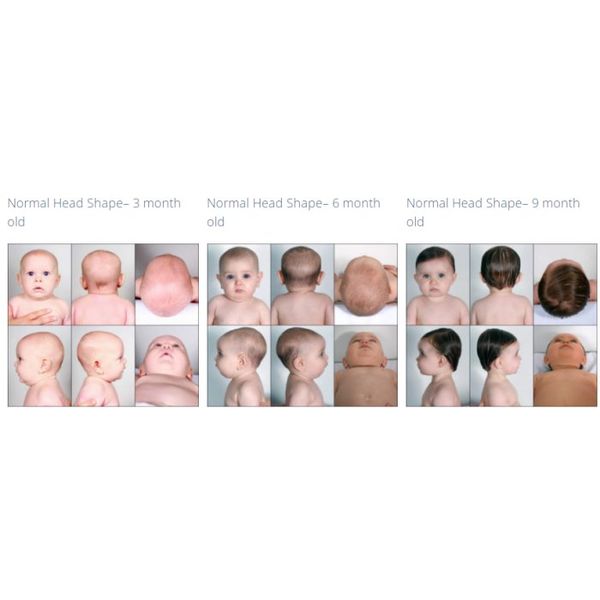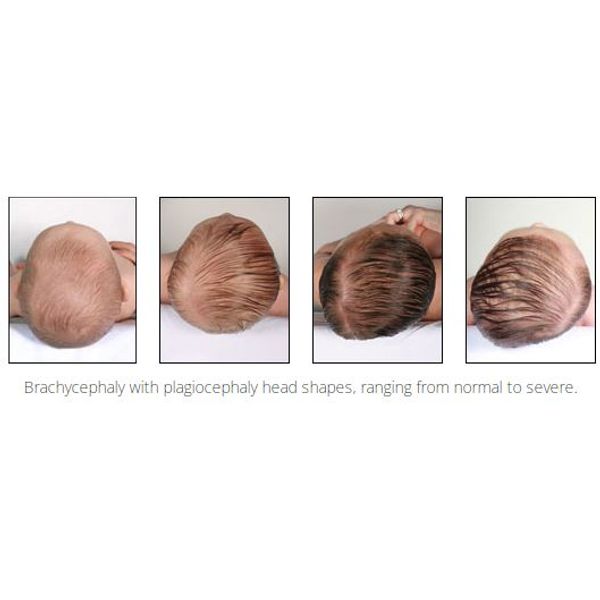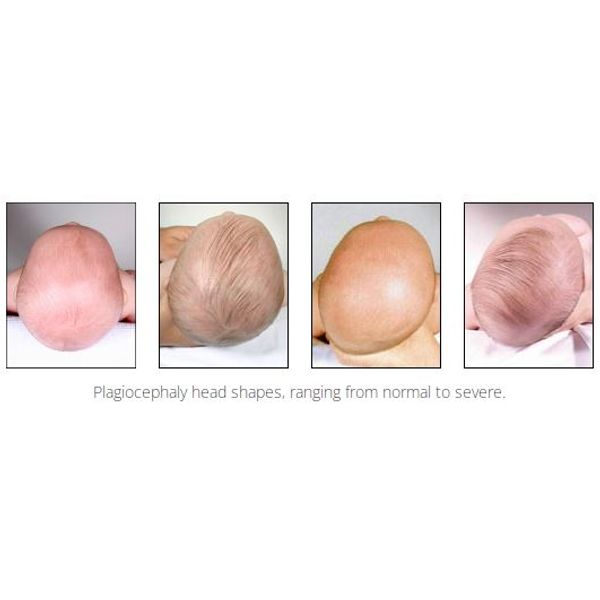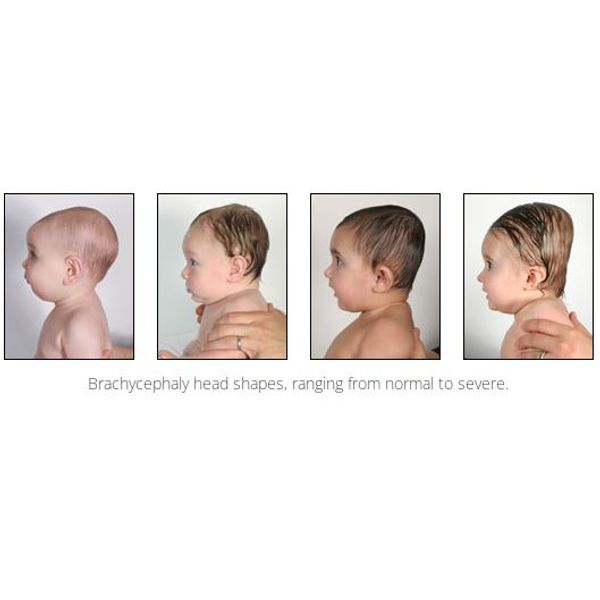

- Home
- Companies
- Cranial Technologies, Inc.
- Products
- DOC Band - Plagiocephaly, Brachycephaly ...

DOC Band - Plagiocephaly, Brachycephaly and Scaphocephaly Device
Sometimes known as “flat head syndrome,” plagiocephaly (pronounced play-jee-oh-sef-uh-lee) is a relatively common condition where an infant develops a flat spot on the back or backside of the head. Many factors can cause flat spots. A baby’s skull is very soft and pressure from everyday surfaces, such as beds or car seats, can cause flattening. No two cases of plagiocephaly are alike.
You may have noticed at bath time while passing a mirror, or perhaps someone commented on the shape of your baby’s head. An abnormal head shape undoubtedly raises many questions, the first of which is common, “am I really seeing what I think I’m seeing?”.
A plagiocephaly diagnosis looks very different from baby to baby, no two cases are alike. You can walk you through evaluating the shape of your baby’s head from five different viewpoints, helping you to better understand your child’s condition and choose the treatment that’s right for her or him.
Please keep in mind, this assessment is not meant to replace an evaluation by a medical professional. We invite you to talk with one of our knowledgeable clinicians directly by scheduling a free evaluation, available at any of our local clinics. You’ll leave with an understanding of your baby’s diagnosis, treatment recommendations, and a detailed report to discuss with your pediatrician.
I. From Above
To get started, have someone hold your baby on their lap while you stand over, looking down at the top of your baby’s head. From this vantage point, what is the general shape of your baby’s head? Normally, the head is roughly 1/3 longer than it is wide. In flat head syndrome, the head may appear flat on one side, wide towards the back, or long and narrow.
Below, we’ve provided examples of three abnormal head shapes you may see. Keep in mind, you may not see these shapes exactly—variations ranging from mild to moderate to severe and even combinations of these shapes can occur.

Normal Head Shape
- Head is 1/3 longer than it is wide
- Ears are aligned
Plagiocephaly Head Shape
- Head is flat on either the back right or left side
- Head shape resembles a parallelogram
- Ears are not aligned
Brachycephaly Head Shape
- Head is wider than it is long
- Back of head is flat rather than curved
Scaphocephaly Head Shape
- Head is long and narrow
II. Profile
Next, with your baby still seated on someone else’s lap or looking into a mirror, look at the shape of your baby’s head from both sides. Normally, the back of the head is curved and both sides of the head match. Look for flattened or sloping areas of the head and check to see if one ear is closer to the shoulder than the other.
Again, some examples are provided for reference below.

Normal Head Shape
- Back of the head is curved
- Both sides of the head match
Plagiocephaly Head Shape
- One ear is closer to the shoulder than the other
- One side of the head appears more curved than the other
Brachycephaly Head Shape
- Head is shortest in length from front to back
- Head is tall in back
- Sloping forehead
- Back of head is flat
Scaphocephaly Head Shape
- Head is longest in length from front to back
III. Ear Alignment

By looking at the alignment of your baby’s ears from above, you can determine the severity of the condition.
While holding your baby in your own lap this time, gently place an index finger at each of his or her ears. How do your fingers line up? A more noticeable misalignment indicates a more severe condition.
What you see here is especially important to note. While plagiocephaly is a highly treatable condition, research has shown that the best results are achieved when treatment starts early. Because cranial helmet therapy is effective for just a short window of time, and severe cases of plagiocephaly are more complex to correct, it’s crucial for babies with advanced forms of the condition to begin treatment as early as possible.
IV. Frontal View
Next, we’ll look at the symmetry of your baby’s face. Because you see your baby’s face every day, the best way to spot differences between the right and left side is to place your baby in front of a mirror and look at his or her reflection. How level are the eyes and top of the head? Is one cheek fuller than the other? How big is the head relative to the face? Examples of what to look for are provided below.

Normal Head Shape
- Eyes are the same size and are level on the face
- Cheeks are the same size
- Top of the head is level
Plagiocephaly Head Shape
- One eye is smaller than the other
- One cheek is fuller than the other
- Head height is not level
- Eyes are not level to one another
- The mouth appears to be asymmetric
Brachycephaly Head Shape
- Face appears small relative to the size of the head
- Head is wide
- Widest part of the head is just above the ears
- Tips of ears protrude
Scaphocephaly Head Shape
- Head is tall and narrow
- Elongated forehead
V. From Below
Lastly, we’ll look at your baby’s head from below. To do this, lay your baby flat on her or his back. With your baby’s face looking directly up towards the ceiling, assess the angle and shape of the forehead and the overall shape of the head. Is the forehead level or sloped? Rounded or square? Does the head appear wide or narrow? Use the examples below for context.

Normal Head Shape
- Eyes and ears are level
- Forehead is arched and level across
Plagiocephaly Head Shape
- Forehead is sloped
- Face is sloped and appears lopsided
- Eyes and ears are not level
- One cheek and side of the face are fuller than the other
Brachycephaly Head Shape
- Head is wide
- Widest part of the head is just above the ears
- The forehead is flat, not rounded
Scaphocephaly Head Shape
- Head is narrow
- Forehead is square
It is best to schedule a free evaluation and allow our highly-trained clinicians to assess your child’s head shape.
The condition, sometimes known as “flat head syndrome,” affects nearly one in two infants today (47%), with one in every ten babies being severe enough that experts would recommend treating with a helmet.
Why Has Plagiocephaly Become More Common In Recent Years?
In the 1990s, the American Academy of Pediatrics (AAP) introduced the Back to Sleep campaign, which urged parents to put infants to sleep on their backs successfully reducing Sudden Infant Death Syndrome (SIDS) by more than half. While the AAP still recommends back-sleeping to prevent SIDS, they have since recognized a correlation between back-sleeping and plagiocephaly.
Will Plagiocephaly Affect My Baby’s Brain Development?
No. While plagiocephaly won’t have any lasting harmful effects on your baby’s neurological development, it is likely that left untreated, the head will remain misshapen into adulthood and may lead to functional challenges as children get older:
- Noticeable facial asymmetry
- Poor fitting eyeglasses
- Poor fitting safety equipment, including sports helmets
- Visible flat areas with short or cropped hairstyles
- Jaw misalignment resulting in a crossbite or underbite
What Does Plagiocephaly Look Like?
Parents spend so much time with their baby, recognizing an abnormal head shape can sometimes be difficult, and a flat spot can form in as little as one week. While plagiocephaly is the most commonly referenced abnormal head shape, plagiocephaly and other shapes can develop to varying degrees of severity and even occur in combination with one another.

Plagiocephaly Head Shape (pronounced play-jee-oh-sef-uh-lee)
- Back of head is flat on one side
- Head shape resembles a parallelogram from above

Brachycephaly Head Shape (pronounced brak-ee-sef-uh-lee)
- Head is wider than normal
- Back of head is flat rather than curved

Scaphocephaly Head Shape (pronounced skaf-oh-sef-uh-lee)
- Head is longer and narrower than normal
- Head is taller than normal
Plagiocephaly, brachycephaly and scaphocephaly can all be accompanied by other characteristics, such as asymmetrical facial features, misaligned ears, and a sloped or bulging forehead. To better understand your baby’s particular condition, take our at-home assessment.
What Causes Plagiocephaly?
Babies’ heads are soft and malleable and even gentle external forces, whether met in the womb or in baby’s daily routine, can cause misshaping. The good news is, babies with plagiocephaly typically respond very well to noninvasive treatments, such as repositioning techniques, which parents can practice at home, and the DOC Band, a custom cranial helmet that redirects baby’s natural growth into a normal head shape. Typically, plagiocephaly can be caused by a variety of different situations such as:
Back-Sleeping
The relationship between back-sleeping and plagiocephaly in infants is well-documented. While the American Academy of Pediatrics still recommends back-sleeping to prevent Sudden Infant Death Syndrome, they also recommend frequent rotation of baby’s head, as well as supervised tummy time. The recommended treatment for unresolved plagiocephaly is cranial helmet therapy.
Carriers & Convenience Devices
While in car seats, bouncy seats and swings, baby’s soft head is often placed against a rigid, unyielding surface. Though normal use is not a concern, extended use—and allowing an infant to sleep in such devices, in particular—increases the risk of plagiocephaly.
Torticollis
Congenital Muscular Torticollis (CMT) is a condition in which the neck muscles are abnormally tight on one side, causing baby’s head to tilt and/or turn to one side. Torticollis often causes the head to be held in a single position, which can lead to plagiocephaly. You can learn more about Torticollis here.
Premature Birth
Premature babies have especially soft skulls, making them even more susceptible to misshaping. These babies often spend extended periods of time in the Neonatal Intensive Care (NICU) unit with the head in a fixed position while on a respirator. Premature babies are also more likely to be physically delayed, which can prevent normal movement of the head.
Womb Position
Babies who become stuck in one position or do not have enough room to move in the womb are at risk of developing plagiocephaly. A breech orientation can also lead to an abnormal head shape.
Multiple Births
Plagiocephaly is common in cases of multiple births, where limited space in utero can lead to distortion of the head.
How Can I Prevent Or Correct Flat Spots?
Simple at-home practices, including supervised tummy time and repositioning techniques, are known to effectively prevent and improve abnormal head shapes. You can learn how to adopt these practices here.
Most insurance companies will require parents to practice repositioning techniques for at least two months before proceeding with a cranial orthotic such as the DOC Band. The DOC Band is the first FDA-cleared device of its kind and is proven to treat plagiocephaly in babies ages 3 to 18 months old. Each helmet is custom made to safely and effectively redirect the baby’s natural growth into a normal head shape.
Parents spend so much time with their baby, recognizing an abnormal head shape can sometimes be difficult. We’ve found it can be helpful to see examples of a normal head shape before looking at abnormal ones. Normally, the head is about 1/3 longer than it is wide and rounded at the back. Below are some examples of a normal head shape at three months, six months and nine months old.

Plagiocephaly means “oblique head” (from Greek “plagio” meaning oblique and “cephale” meaning head). The baby’s head shape resembles a parallelogram from above. Parents and medical professionals can look for these characteristics:
- Head is flat on one side
- One ear is more forward than the other
- One eye is smaller than the other
- One cheek is fuller than the other
- Top of the head is not level
- Head shape resembles a parallelogram from above
As you might expect, babies with brachycephaly and plagiocephaly share characteristics of both head shapes. In these cases, the head is abnormally tall and wide and resembles a distorted trapezoid from above. These are the traits parents and doctors can look for:
- A combination of plagiocephaly and brachycephaly traits
- Head is wider and taller than normal
- Forehead is sloped
- Ears and eyes appear misaligned
- Head shape resembles a distorted trapezoid from above


Brachycephaly is rooted in Latin, “brachy” meaning short and “cephaly” meaning head. The back of the head becomes flat, causing an abnormally wide, tall head shape. Parents and medical professionals should look for these characteristics:
- Head is wider than normal
- Head is abnormally tall
- Back of head is flat rather than curved
- Face appears small relative to the size of the head
- Widest part of the head is just above the ears
- Tips of ears protrude
- Head shape resembles a trapezoid from above

